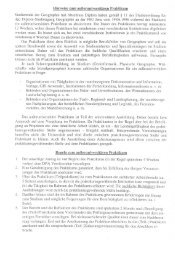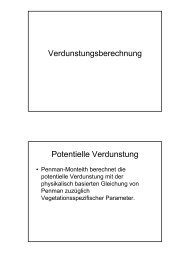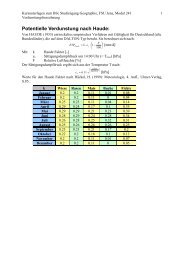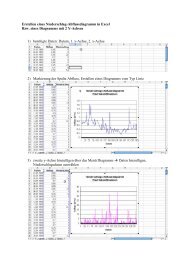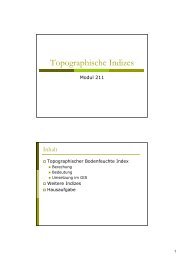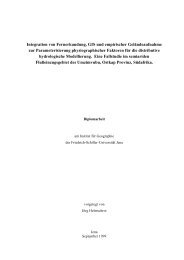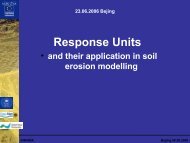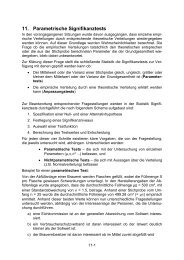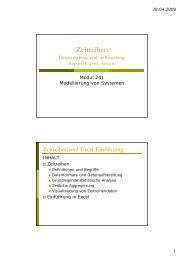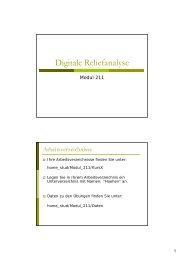Fernerkundung I (Digitale Bildverarbeitung) - Friedrich-Schiller ...
Fernerkundung I (Digitale Bildverarbeitung) - Friedrich-Schiller ...
Fernerkundung I (Digitale Bildverarbeitung) - Friedrich-Schiller ...
You also want an ePaper? Increase the reach of your titles
YUMPU automatically turns print PDFs into web optimized ePapers that Google loves.
FELEE<br />
FFROST<br />
FGAMMA<br />
KUAN<br />
FLE<br />
FME<br />
FMO<br />
FPR<br />
FPRE<br />
SHARP<br />
FSOBEL<br />
FSPEC<br />
LINE<br />
SIEVE<br />
MODEL<br />
ARI<br />
Enhanced Lee Adaptive Filtering (up to 11x11), Performs enhanced<br />
Lee adaptive filtering on image data. The enhanced Lee Filter is<br />
primarily used on radar data to remove high frequency noise<br />
(speckle) while preserving high frequency features (edges).<br />
Frost Adaptive Filtering (up to 33x33) FFROST is used primarily to<br />
filter speckled SAR data. An adaptive Frost filter smooths image<br />
data, without removing edges or sharp features in the images.<br />
Gamma Filtering (up to 11x11), Performs gamma map filtering on<br />
image data. The gamma map filter is primarily used on radar data<br />
to remove high frequency noise (speckle) while preserving high<br />
frequency features (edges).<br />
Kuan Filtering (up to 11x11), Performs Kuan filtering on image data.<br />
The Kuan filter is primarily used on radar data to remove high<br />
frequency noise (speckle) while preserving high frequency features<br />
(edges).<br />
Lee Adaptive Filtering (up to 11x11), Performs Lee adaptive filtering<br />
on image data. The Lee Filter is primarily used on radar data to<br />
remove high frequency noise (speckle) while preserving high<br />
frequency features (edges).<br />
Median Filter (up to 7x7) Performs MEDIAN filtering on image data.<br />
The median filter smooths image data, while preserving sharp<br />
edges.<br />
Mode Filter (up to 7x7) Performs MODE filtering on image data. The<br />
Mode filter is primarily used to clean up thematic maps for<br />
presentation purposes.<br />
Programmable Filter (up to 33x33), Performs programmable<br />
filtering on image data. The programmable filter averages image<br />
data according to user specified weights.<br />
Prewitt Edge Filter (3x3), Performs PREWITT EDGE DETECTOR<br />
filtering for Image data. The Prewitt edge detector filter creates an<br />
image where edges (sharp changes in grey-level values) are shown.<br />
Sharpening Filter (up to 33x33) Performs an edge sharpening filter<br />
on image data. This filter improves the detail and contrast within an<br />
image.<br />
Sobel Edge Filter (up to 3x3), Performs SOBEL EDGE DETECTOR<br />
filtering for Image data. The Sobel edge detector filter creates an<br />
image where edges (sharp changes in grey-level values) are shown.<br />
SAR Speckle Filters Applies a speckle filter on a SAR image. The<br />
supported filters are: Lee Filter, Kuan Filter, Frost Filter, Enhanced<br />
Lee Filter, Enhanced Frost Filter, Gamma MAP Filter and Touzi Filter.<br />
These filters are primarily used on radar data to remove high<br />
frequency noise (speckle), while preserving high frequency features<br />
(edges). For convenience, a Block Average Filter and a Standard<br />
Deviation Filter are also provided.<br />
Lineament Extraction Extracts linear features from an image and<br />
records the polylines in a vector segment. This program is designed<br />
for extracting lineaments from radar images. However, it can also<br />
be used on optical images to extract curve-linear features.<br />
Sieve Filter (Class Merging) Reads an image channel, and merges<br />
image value polygons smaller than a user specified threshold with<br />
the largest neighbouring polygon. This is typically used to filter<br />
small classification polygons from a classification result.<br />
Modelling environment (can be used instead of EASI)



